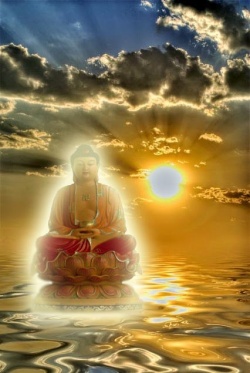Dhyani Mudra
Dhyani means mediation in Sanskrit. Dhyani mudra is the gesture of meditation of contemplation.This is a classic meditation pose and a gesture of submission.
1) Place both of your hands in your lap. Hands should form the shape of bowls.
2) Left hand should lie in the right hand and both thumbs should touch each other.
3) This is the traditional meditation pose.
The two hands formed into a bowl shape show that we are inwardly free, pure, and empty in order to receive everything that we need on our spiritual path. As there is no empty space in the universe and everything is full of some subtle energy.
This void made with our hands will become new empty space and will get filled with new energy. Here is one very important point – our thoughts and feelings determine the quality of this new energy.
This is why it is so important to have done the work of forgiveness beforehand and live in peace with all beings. In this meditation posture, emptiness is brought to mind with dhyani mudra,
This means that your mind is thoughtless at the point of time. In usual, this is extremely difficult. Our mind is always wandering between the pools of thoughts.
Mudra of meditation and concentration and of attainment of spiritual perfection.
Assumed to be the mudra the Buddha adopted when meditating and reaching enlightment under the Pipal tree.
Gesture also adopted since time immemorial by yogis during concentration and mediation excercises.
Indicating perfect balance of thought, rest of senses and tranquility.
May be made with one or both hands. When made with a single hand the left one is placed in the lap, while the right may be engaged elsewhere.
The left hand making the Dhyana mudra in such cases symbolizes the female left-hand principle of wisdom. Ritual objects such as a text, or more commonly an alms bowl symbolizing renunciation, may be placed in the open palm of this left hand.
When made with both hands, the hands are generally held at the level of the stomach or on the thighs. The right hand is placed above the left, with the palms facing upwards, and the fingers extended. In some cases the thumbs of the two hands may touch at the tips, thus forming a mystic triangle.
Position of the Samadhi mudra with the joined thumbs forming a triangle is symbolic of the Triratna (Three Jewels) namely the Buddha, Dharma and Sangha. The triangular form also indicates the firmness of the body and of the mind.
Second version of Dhyani Mudra
In the re framed version of dhyani mudra, the attention is directed at breathing. That is all the five senses should be focused on the breath.
Benefits of dhyani mudra
1) Dhyani mudra helps to concentrate in meditation.
2) It calms the mind and helps it to attain the stage of thoughtlessness.
About Mudras
Mudras are hand gesture which influences the energy in the body.
In East, Mudras have been in use for thousands of years.
Mudras have balancing effect on five elements.
It is said that mudras can balance the elements within 45 minutes. So generally it is advisable to do mudra for 45 minutes in a day.
Mudras, or hand yoga as they’re also known as, is something unknown to many while in fact we can control much of our body through our hands.
By consciously placing your hands and fingers in different positions can assist you physically, spiritually as well as emotionally.
One of the prettiest mudras is the Dhyani mudra that forms into a sort of bowl in your lap and that is commonly used in meditation. This is symbolic of emptying yourself to be filled with light.
The gifts of light might come in many forms, like expansion of consciousness, greater insight or ease of mind. The point is to let whatever comes come, and trust that you are being cared for.
Sitting in lotus position, or just sitting in a chair, place your hands in your lap, palms facing upwards, one hand op top of the other, and let the thumbs touch.
This will form a bowl to symbolise inner purity and emptiness that is ready to become filled with new energy.
While you sit in this position, try to keep your mind silent. Remember you’re opening yourself up to be filled. You can envision a clear blue sky on a sunny day and let any tought be clouds that simply drift by, trying to keep the sky as clear as possible.
You can do this a few minutes a day as a practice in hand yoga, or you can work it into your daily meditations.
by Agathe Molvik. </poem>

